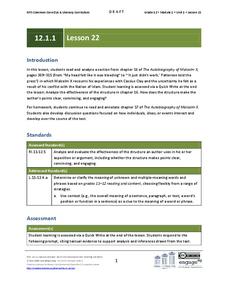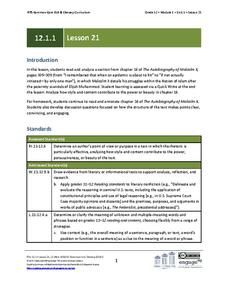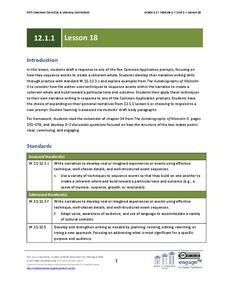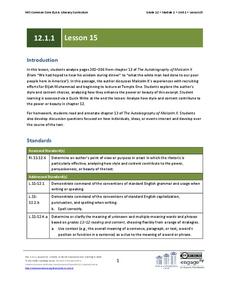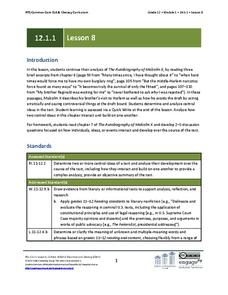EngageNY
Grade 12 ELA Module 1: Unit 1, Lesson 24
Today's discussion of The Autobiography of Malcolm X focuses on the precise words, the telling phrases, and the sensory details Haley uses to enliven his story. Writers then work to incorporate these same techniques in the draft of their...
EngageNY
Grade 12 ELA Module 1: Unit 1, Lesson 23
Malcolm X's journey to Cairo, his Hajj, his Letter from Mecca detailing his insights into "true Islam," and his transition to Al-Hajj Malik El-Shabazz are the focus of the discussion of chapter 17 of The Autobiography of Malcolm X.
EngageNY
Grade 12 ELA Module 1: Unit 1, Lesson 22
Using their annotations and questions developed as homework, class members discuss chapter 16 of The Autobiography of Malcolm X and the narrative techniques Haley uses to heighten the tension and power of the events at this turning point...
EngageNY
Grade 12 ELA Module 1: Unit 1, Lesson 21
". . .the chickens have come home to roost." Chapter 16 of The Autobiography of Malcolm X is the focus of this lesson plan. Readers use their worksheets to record evidence of character development and Haley's stylistic choices that...
EngageNY
Grade 12 ELA Module 1: Unit 1, Lesson 19
Class members return to a discussion of The Autobiography of Malcolm X, discussing how Haley foreshadows the growing distrust and downturns in the influence of the Nation of Islam.
EngageNY
Grade 12 ELA Module 1: Unit 1, Lesson 18
Class members take a break from discussing The Autobiography of Malcolm X to focus on their personal narrative essays. Before working on their drafts, they review what they have learned from their study of Haley's narrative about...
EngageNY
Grade 12 ELA Module 1: Unit 1, Lesson 17
Integration versus separation. Readers of chapter 14 of The Autobiography of Malcolm X examine Malcolm X's views on other Civil Rights leaders and their integration ideas. Class members also return to the narrative essay strand of the...
EngageNY
Grade 12 ELA Module 1: Unit 1, Lesson 16
Class members discuss Chapter 13 of The Autobiography of Malcolm X and use evidence from their character development worksheet to support an analysis of how Malcolm X and attitudes toward him and his teachings are changing.
EngageNY
Grade 12 ELA Module 1: Unit 1, Lesson 15
Chapter 12 of The Autobiography of Malcolm X discusses Haley's narrative techniques, mainly how he uses point of view and foreshadowing to build interest and suspense. Class members read and annotate chapter 13 of the text as homework...
EngageNY
Grade 12 ELA Module 1: Unit 1, Lesson 14
As a mid-unit assessment, individuals craft an in-class, formal essay response to a prompt that asks them to use textual evidence to identify Haley's purpose, as well as analyze how the structure, style, and content contribute to the...
EngageNY
Grade 12 ELA Module 1: Unit 1, Lesson 12
Writers use class time to develop the draft of their personal narratives, drawing on techniques Haley uses in The Autobiography of Malcolm X.
EngageNY
Grade 12 ELA Module 1: Unit 1, Lesson 13
Readers of The Autobiography of Malcolm X continue their analysis of the methods Haley uses to show how Malcolm X is changing due to his exposure to the teachings of Elijah Muhammad.
EngageNY
Grade 12 ELA Module 1: Unit 1, Lesson 11
Chapter 10 of Malcolm X's Autobiography introduces readers to Elijah Muhammad's teachings. Discussion questions focusing on syntax and diction draw attention to how Malcolm X's perspective on Mr. Muhammad changes.
EngageNY
Grade 12 ELA Module 1: Unit 1, Lesson 10
Readers examine the rhetorical devices Haley uses in chapter 8 of The Autobiography of Malcolm X, paying particular attention to the diction and syntax and how these choices reveal changes in Malcolm X's point of view.
EngageNY
Grade 12 ELA Module 1: Unit 1, Lesson 9
As they read and discuss Chapter 7 of The Autobiography of Malcolm X, class members continue to use the Tracking Tool worksheet to record evidence on how the central ideas are being developed.
EngageNY
Grade 12 ELA Module 1: Unit 1, Lesson 8
Readers use the provided worksheet to analyze the narrative techniques Haley uses in chapter 6 of The Autobiography of Malcolm X to continue the development of the central ideas of racial identity and systemic oppression.
EngageNY
Grade 12 ELA Module 1: Unit 1, Lesson 7
Readers of The Autobiography of Malcolm X examine how Haley's word choice and point of view in chapter 5 reveal Malcolm X's attitude toward his behavior as he travels from Lansing to Harlem.
EngageNY
Grade 12 ELA Module 1: Unit 1, Lesson 6
To prepare for drafting their Common Application narrative, class members return to the opening pages of The Autobiography of Malcolm X and examine how Haley engages and orients readers, establishes his narrator and point of view, and...
EngageNY
Grade 12 ELA Module 1: Unit 1, Lesson 5
Zoot suits, the Lindy hop, and conks. Readers carefully examine the rhetoric of chapter 4 of The Autobiography of Malcolm X, analyze the effectiveness of using slang to develop a narrative, and consider how they might incorporate Haley's...
EngageNY
Grade 12 ELA Module 1: Unit 1, Lesson 4
Chapter 3 of The Autobiography of Malcolm X discusses how central ideas are developed in a narrative. Readers use the provided annotated bookmark to record evidence of ideas such as racial identity, integration/separation, and systemic...
EngageNY
Grade 12 ELA Module 1: Unit 1, Lesson 3
Using questions they developed, class groups discuss Chapter 2 of Malcolm X's autobiography, focusing on the individuals and events Malcolm X feels contributed to his character development.
EngageNY
Grade 12 ELA Module 1: Unit 1, Lesson 1
Here's a fresh approach to the dreaded personal narrative required by most college applications. The Autobiography of Malcolm X is the anchor text for a unit that, through modeling and guided practice exercises, encourages the...
EngageNY
Preparing to Write Historical Fiction: Determining Characteristics of the Genre
A language arts instructional activity helps young writers identify elements that make up historical fiction. First, it guides them through elements of fictional pieces with vocabulary cards. Then, pupils work collaboratively to...
EngageNY
Planning Ideas: Developing a Colonial Character Profile
The second lesson in a historical fiction series encourages pupils to develop a character profile of a colonial person using research acquired in the previous unit. Learners prepare their historical fiction narrative by responding to a...




